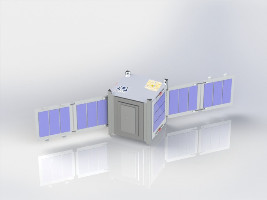| Name | K´OTO (K’OTO, K'OTO, KOTO, KAOTO) |
|---|---|
| Spacecraft type | CubeSat |
| Units or mass | 1U |
| Status | not launched, expected in 2025 |
| Launcher | not launched |
| Organisation | National Autonomous University of Mexico |
| Institution | University |
| Entity | Academic / Education |
| Nation | Mexico |
| Launch brokerer | JAXA, KiboCUBE |
| Oneliner |
Educational mission to contribute to technological and human resources development. |
| Description |
K'OTO aims to contribute to the technological development and specialized human resources in the space area, promoting the development of national technology with social impact bene ting the quality of life of the Mexican population. This project there is the participation of both academic and private international institutions. "The name of this nanosatellite is based on the Otomi language term KOTO, which means in English “grasshopper”, this refers to the fact that this project, despite its size, will allow a great Academic, technological leap in the development of experimental Mexican space projects, maintaining the cultural roots of Mexico and in this case the original dialect (Otomi) of the state of Querétaro. The nanosatellite KOTO is an academic initiative in progress in the National Autonomous University of Mexico (UNAM) through the Advanced Technology Unit (UAT) of the college of engineering, at the Juriquilla, Querétaro. The goal of the KOTO project is to develop, integrate and put into orbit a CubeSat Amateur type nanosatellite from the International Space Station (ISS). The KOTO mission consists of testing two low-resolution cameras to take photographs of the Mexican territory and transmit them to the ground for the radio amateur’s community of the country experimenting in the amateur radio band. The development of this experimental satellite involves mainly undergraduate students from various Mexican institutions such as: UNAM, UAQ, UNITEC, ITQ and UPSRJ, from multiple areas, promoting multidisciplinary work and promoting the training of human resources in the space area. Through teamwork, multidisciplinary and multi-institutional collaboration, promoting the use of experimentation in the amateur radio bands. The project consists of the design, manufacture, integration, testing, launching, putting into orbit and operation of an experimental nanosatellite under the CubeSat standard. The development of this project in addition, aims to be a technological demonstrator through which the students participating in the project will have the opportunity to develop several subsystems that make up the nanosatellite, carry out the integration and participate in the pre-certification tests of the systems within of the facilities of the UAT-FI-UNAM in the Mexican state of Querétaro, which houses the National Laboratory for Space and Automotive Engineering (LN-INGEA). The KOTO nanosatellite is planned to be put into orbit in the first half of 2022 from the International Space Station (ISS) through collaboration with the Kyushu Institute of Technology (Kyutech) who will be in charge of carrying out the tests of flight certification and subsequently deliver the satellite to JAXA for its launch, with this collaboration the training of human resources and technology is reinforced internationally. The project will strengthen the use of amateur radio communications because it is a university nanosatellite developed by students and radio amateurs with a strong interest in satellite communications. For Mexico it is a great opportunity for young university students and radio amateurs to experiment with a real project that promotes the service of radio amateurs using satellites, a unique experience for students and fans from Mexico and the world who have a Yagi antenna and a radio amateur tuned to the requested frequencies. Finally, the mission of the experimental nanosatelite KOTO will contribute to the advancement of the amateur satellite service since its transmissions will be open to all radio amateurs from Mexico and mainly from Latin America. KOTO will contribute to the training of new fans because the project encourages young people to experiment with antennas, radios, software, etc. The university and institutions of higher education in Mexico will have the great opportunity to also contribute to the training of radio amateurs by satellite, an experience that will be shared with many countries of the world, always with the banner of experimentation and peace. The project also aims to inspire young people and the Amateur Radio community." |
| Sources | [1] [2] [3] [4] [5] [6] [7] [8] |
| Photo sources | [1] |
| Subsystems sources | [1] |
Last modified: 2024-12-19

